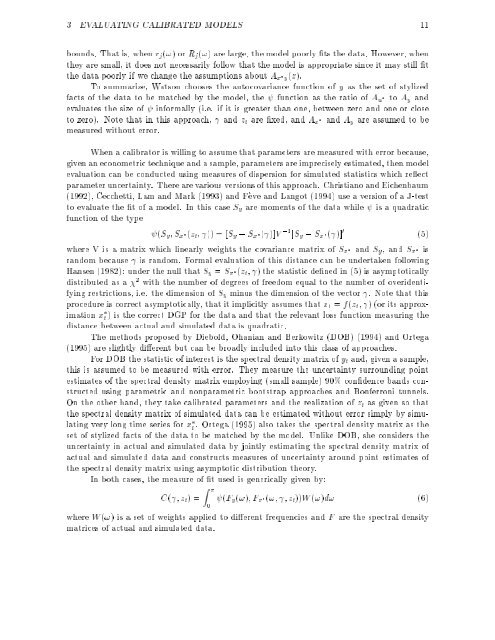Testing Calibrated General Equilibrium Models - Universitat ...
Testing Calibrated General Equilibrium Models - Universitat ...
Testing Calibrated General Equilibrium Models - Universitat ...
You also want an ePaper? Increase the reach of your titles
YUMPU automatically turns print PDFs into web optimized ePapers that Google loves.
3 EVALUATING CALIBRATED MODELS 11<br />
bounds. That is, when rj(!) orRj(!) are large, the model poorly ts the data. However, when<br />
they are small, it does not necessarily follow that the model is appropriate since it may still t<br />
the data poorly if we change the assumptions about Ax y(z).<br />
To summarize, Watson chooses the autocovariance function of y as the set of stylized<br />
facts of the data to be matched by the model, the function as the ratio of Au to Ay and<br />
evaluates the size of informally (i.e. if it is greater than one, between zero and one or close<br />
to zero). Note that in this approach, and zt are xed, and Ax and Ay are assumed to be<br />
measured without error.<br />
When a calibrator is willing to assume that parameters are measured with error because,<br />
given an econometric technique and a sample, parameters are imprecisely estimated, then model<br />
evaluation can be conducted using measures of dispersion for simulated statistics which re ect<br />
parameter uncertainty. There are various versions of this approach. Christiano and Eichenbaum<br />
(1992), Cecchetti, Lam and Mark (1993) and Feve and Langot (1994) use a version of a J-test<br />
to evaluate the t of a model. In this case Sy are moments of the data while is a quadratic<br />
function of the type<br />
(SySx (zt )) = [Sy ; Sx ( )]V ;1 [Sy ; Sx ( )] 0<br />
where V is a matrix which linearly weights the covariance matrix of Sx and Sy, andSx is<br />
random because is random. Formal evaluation of this distance can be undertaken following<br />
Hansen (1982): under the null that Sy = Sx (zt ) the statistic de ned in (5) is asymptotically<br />
distributed as a 2 with the number of degrees of freedom equal to the numberofoveridentifying<br />
restrictions, i.e. the dimension of Sy minus the dimension of the vector . Note that this<br />
procedure is correct asymptotically, that it implicitly assumes that xt = f(zt ) (or its approximation<br />
xt ) is the correct DGP for the data and that the relevant loss function measuring the<br />
distance between actual and simulated data is quadratic.<br />
The methods proposed by Diebold, Ohanian and Berkowitz (DOB) (1994) and Ortega<br />
(1995) are slightly di erent but can be broadly included into this class of approaches.<br />
For DOB the statistic of interest is the spectral density matrix of yt and, given a sample,<br />
this is assumed to be measured with error. They measure the uncertainty surrounding point<br />
estimates of the spectral density matrix employing (small sample) 90% con dence bands constructed<br />
using parametric and nonparametric bootstrap approaches and Bonferroni tunnels.<br />
On the other hand, they take calibrated parameters and the realization of zt as given so that<br />
the spectral density matrix of simulated data can be estimated without error simply by simulating<br />
very long time series for xt . Ortega (1995) also takes the spectral density matrix as the<br />
set of stylized facts of the data to be matched by the model. Unlike DOB, she considers the<br />
uncertainty in actual and simulated data by jointly estimating the spectral density matrix of<br />
actual and simulated data and constructs measures of uncertainty around point estimates of<br />
the spectral density matrix using asymptotic distribution theory.<br />
In both cases, the measure of t used is generically given by:<br />
C( zt) =<br />
Z<br />
0<br />
(5)<br />
(Fy(!)Fx (! zt))W (!)d! (6)<br />
where W (!) is a set of weights applied to di erent frequencies and F are the spectral density<br />
matrices of actual and simulated data.
















